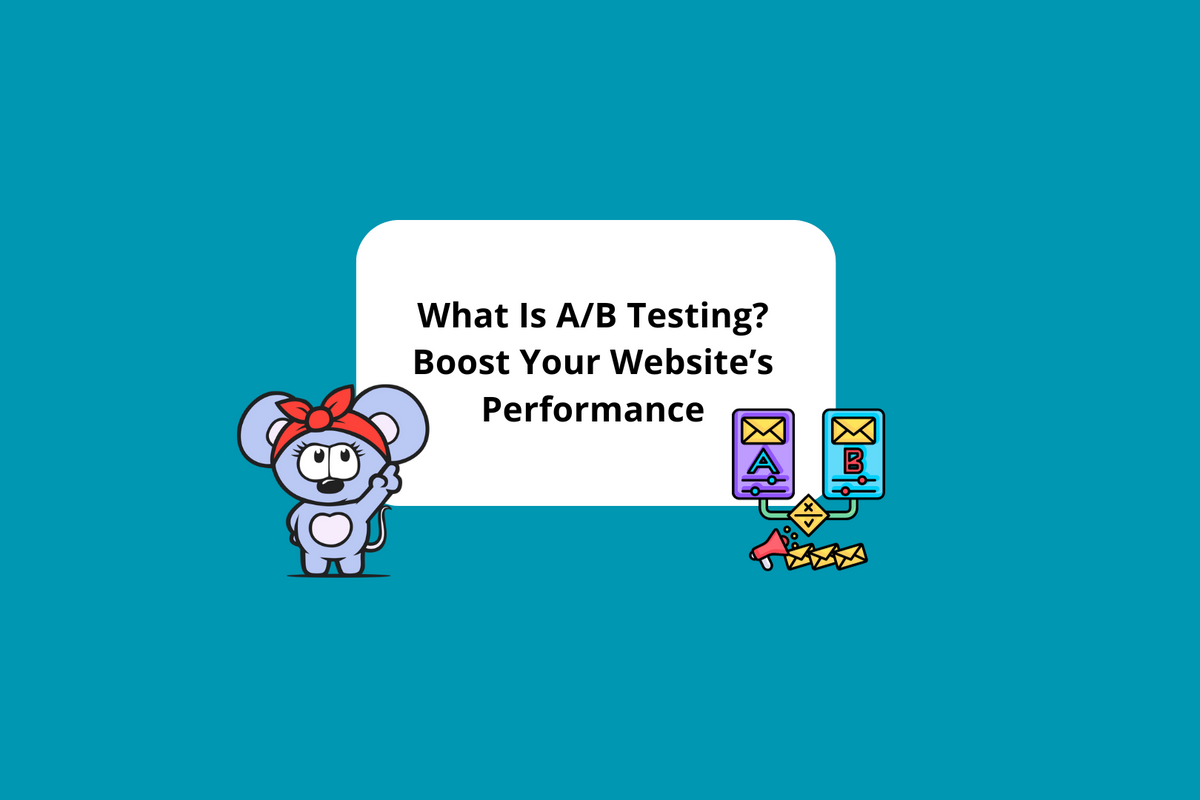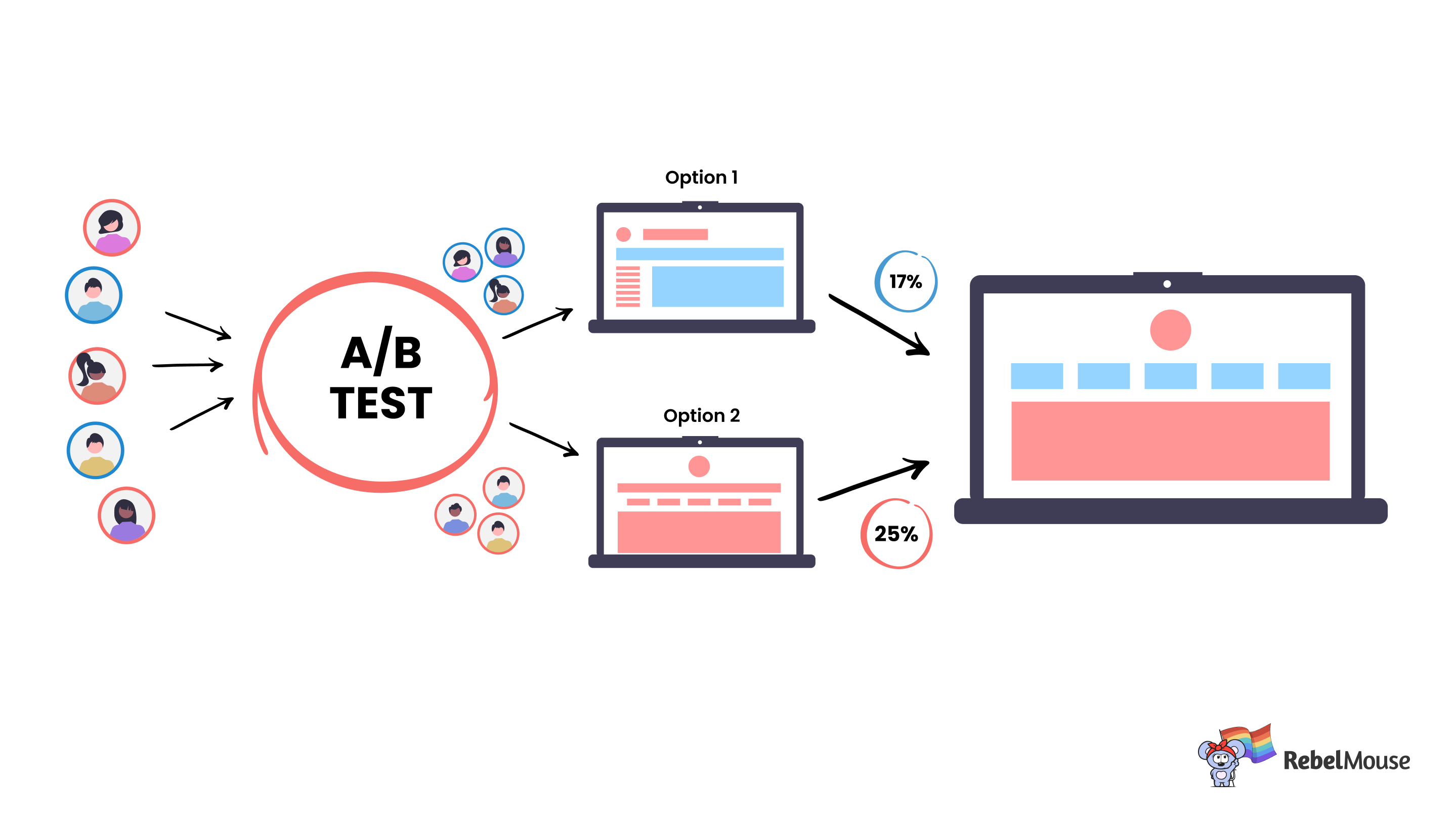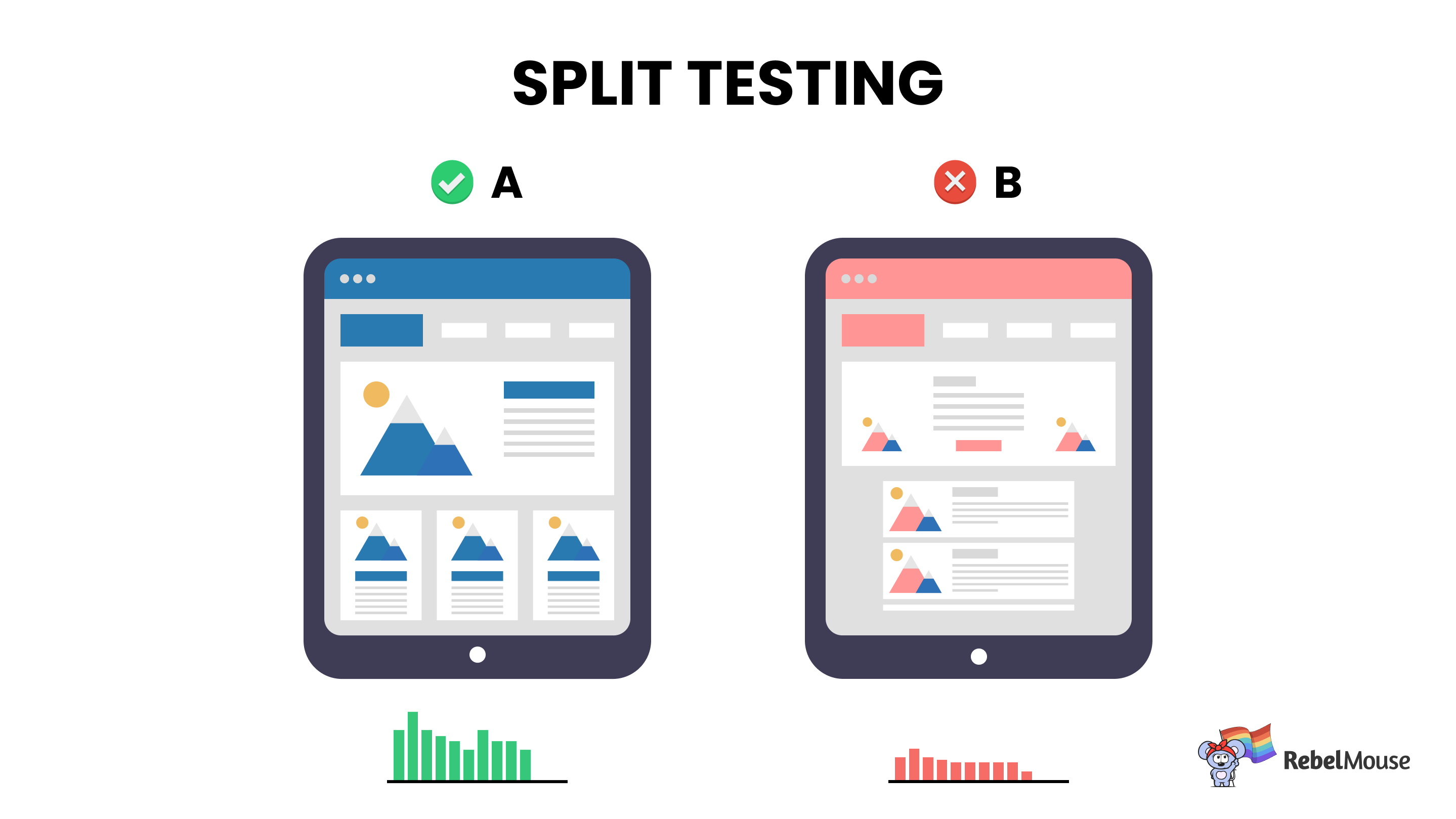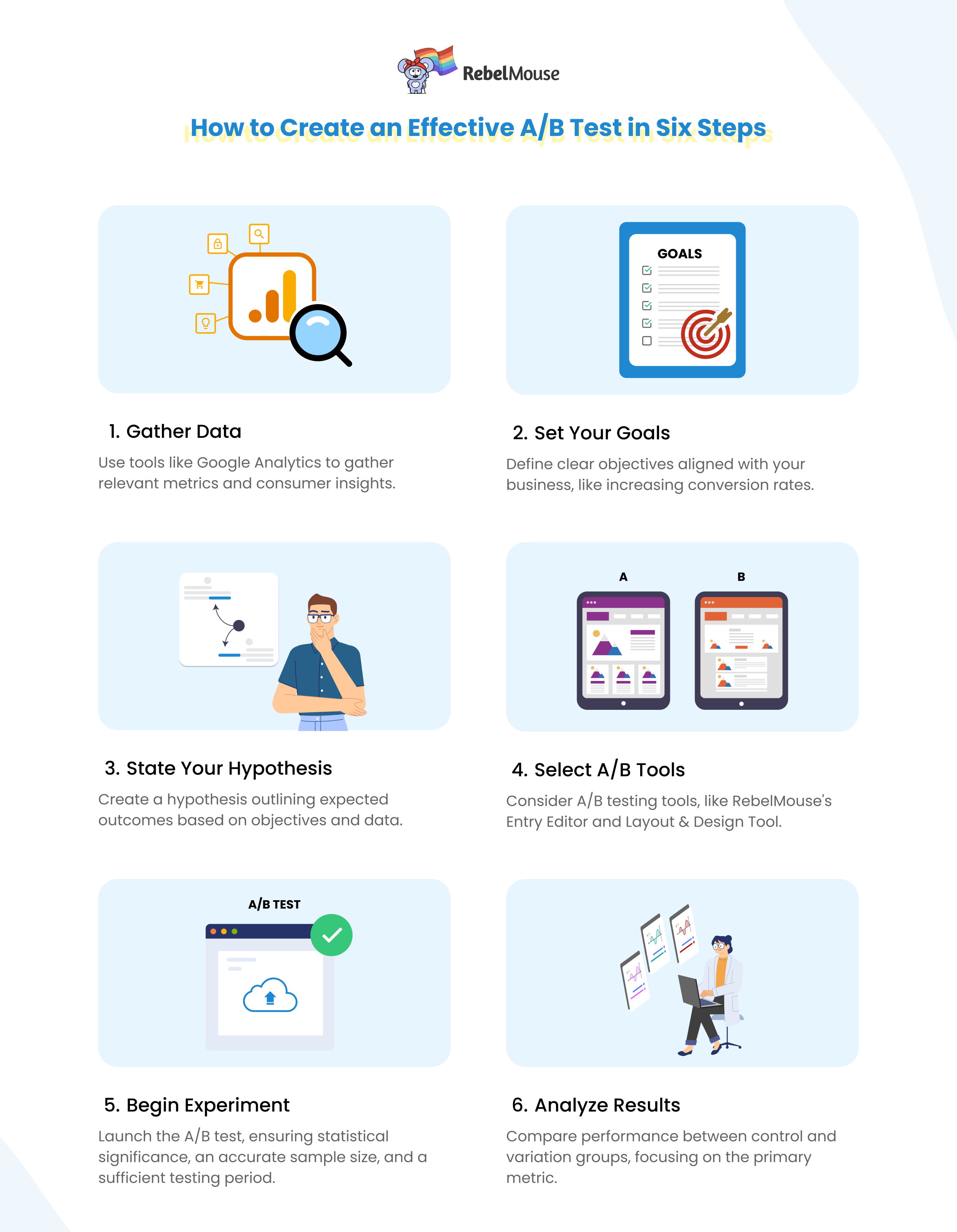
This guide covers A/B testing, its definition, advantages, and real-world applications. We will also go over how A/B testing works, ways to implement it in your SEO practices, and common roadblocks that may come up when evaluating test results. Now, let's see how A/B testing can improve your website’s performance.
What Is A/B Testing?
A/B testing, also called split testing or bucket testing, is a type of experimental testing in which you divide your audience into two groups and present them with different versions of a web page or app element. Group A sees one version of a page, and group B sees another version. The goal of A/B testing is to identify which variation performs better in terms of user engagement, conversion rates, and improving your online presence.
How A/B Testing Works
In an A/B test, businesses create two versions of a web page or an app element: A and B. A is the control page, and B is the variation page that may slightly change the headline, button design, or layout. Half of the users see A (control), and the other half see B (variation). You can then measure each version's performance based on user clicks and conversions.
A/B Testing Example #1: Subject Lines
One example of A/B testing includes subject lines. Imagine group A receives a promotional newsletter titled "Essential Natural Products for Women," and group B receives a variation titled "Must-Have Natural Products for Women in 2024." Whichever headline receives more clicks is the one that appeals most to your audience, which will help you understand your audience's preferences and online behaviors better and increase the likelihood of converting them. Utilizing an AI headline generator may help you during the brainstorming phase.
A/B Testing Example #2: Page Layout
Let's say you want to measure how many clicks an advertisement gets depending on where it appears. Group A receives the original version with the ad displayed on the side of the screen. In contrast, group B gets a different version of the web page with the advertisement positioned at the bottom of the screen. If the ad on the side of the screen earns more clicks, placing side-screen ads may be more beneficial for your business.
Benefits of A/B Testing
There are several reasons why you would A/B test, including:
- Making Decisions Based on Data: You can use numerical data from A/B testing rather than assuming or generalizing what your users might like to make more informed decisions and drive more positive results.
- Improving User Experience: A/B testing allows you to identify what content and designs appeal most to your customers, which can enhance how visitors interact with your website, leading to better user experiences.
- Consistently Improving Your Site: You can meet business goals and fine-tune your website to meet your users' needs, leading to a lower bounce rate, higher click-through rates (CTR), and increased conversions.
- Enhancing Marketing Strategies: You can optimize your marketing campaigns by testing copy, web layouts, design elements, and call-to-action (CTA) buttons to create the perfect pages that bring more exposure to your brand.
- Optimizing Interface and Design: A/B testing previews how an audience may react to interface modifications, allowing designers and marketers to improve user engagement, styles, and product features if necessary.
A/B Testing in Marketing
Here are some ways you can use A/B testing in marketing to assess and improve your strategies:
- Headlines: You can test different titles to see which appeal more to users and yield a higher CTR.
- CTA Buttons: You can compare call-to-action button placements, colors, and font sizes, and experiment with text variations such as “Sign Up Now” or “Find Out More” to determine what captures the most attention.
- Email Subject Lines: A/B test subject lines in email marketing campaigns to boost open rates and CTR.
- Layout and Navigation: Test different layouts and navigation structures, such as adding sticky elements or a scroll-to-top menu button to optimize the user flow and reduce bounce rates.
- Social Proof: Compare the impact of social proof elements, such as testimonials, reviews, or ratings.
Those are just a handful of the numerous ways you can use A/B testing to improve specific goals and elevate user experiences across a website or app.
How to Create an Effective A/B Test in Six Steps
Running an A/B test doesn’t have to be a complicated process. Before testing multiple variables at once, prioritize which elements are most important to the user experience and comparable in an experiment. Some examples include font size, images, headlines, social, color scheme, and layout.
To create your A/B test, follow the steps below:
1. Collect Data
Before starting an A/B test, businesses need to collect relevant data to pinpoint areas of improvement. Use analytics tools like Google Analytics or Google Search Console to examine metrics such as website traffic, bounce rate, CTR, trends, drop-off rates, and user behavior. First-party data sources such as email open rates, purchase history, lead generation forms, social media insights, surveys, and audience demographics are a few ways to discover consumer insights.
2. Establish Your Goals
Clearly define the goals you want to achieve with A/B testing. It could be increasing conversion rates, boosting traffic, decreasing bounce rates, improving click-through rates, raising brand appeal, or any other metric aligned with your business objectives.
3. State Your Test Hypothesis
A test hypothesis calculates the probability of an assumption in light of your objectives and data collection. This hypothesis should describe how and why changes in your variable should result in a specific outcome.
Imagine that you want to increase the sales driven by your e-commerce product page. For the A/B test, you send out one version of the page with the typical product description, and your variation replaces the product description with a short video that highlights the product's features.
You might hypothesize that video advertisements will result in a 10% increase in add-to-cart rates.
4. Select Your A/B Testing Tools
Selecting the appropriate A/B testing tools is the first step in improving content, be it a blog post, an email, or a web page. You can compare headlines using tools like RebelMouse's integrated headline tools, which allow you to target particular audiences to see how they respond. You can also A/B test your website layout, distributing variations across equal groups or a randomized sample with the help of adjustable sample size parameters.
Depending on your desired outcomes, you will use different A/B tools. For instance, you might use different A/B testing tools for design testing than you would for emails. To help you optimize your workflow, find out if your content management system (CMS) has integrated or built-in A/B tools. Google Analytics also offers web page A/B testing for non-RebelMouse users.
5. Run Experiment
Launch the A/B test and assign users to the control group (version A) or the variation group (version B). Consider these points when running your experiment:
- Statistical Significance: Make sure the test is statistically significant, which means that your dependent variables and data will be used to determine the results rather than a random, inexplicable chance.
- Sample Size: Make sure a sufficient sample size produces accurate results. An excessively large or small sample size will yield inaccurate results. Use a sample size calculator to prevent this.
- Period: Give the test enough time to run if you're testing metrics like pageviews or bounce rate. Let your test variations run simultaneously for at least one month for the most accurate and statistically significant results.
- User Feedback: During your test, you can send out surveys to users to get their input. You can learn more about someone's online habits by asking why they didn't click past a particular page or on a CTA button. You can find out if they felt the information needed to be more relevant to them or if the content needed to be shorter.
6. Analyze Results
Once the test is finished, analyze the results. Compare the performance of the control group and the variation group to determine which version performed better. Remain focused on the primary metric you selected to assess and avoid getting distracted by the experiment's other outcomes. Ignore the quantity of conversions if you have chosen to test the bounce rate of a web page. Apply the results to your next action plan. If one test outperformed the original, consider applying those changes to multiple pages on your site.
A/B Testing and SEO
A/B testing is generally safe and encouraged by Google. However, it’s essential to follow best practices to avoid any negative impact on your search rankings. Avoid practices like cloaking (showing search engines different content than what users see), and use attributes and 302 redirects (temporarily redirecting users to a specific page) when necessary to maintain the integrity of your website's search rank. Google also offers insights on minimizing the A/B testing impact on Google Search.
Challenges and Considerations for A/B Test Results
When interpreting A/B test results, it's essential to be aware of the following critical challenges:
- Inaccurate Sample Size: Ensure that your sample size is large enough to produce reliable and statistically significant results. A sample size that is too large or too small will yield unreliable results.
- The Shiny and New Syndrome: When conducting your test, remember that when something new or unique appears on your website, users may become more engaged because they are experiencing something different. To prevent this, concentrate on first-time visitors who will be able to handle the changes and will view your site with a fresh perspective.
- Outside Influences: During your A/B test, some factors will be beyond your control, such as a platform outage or seasonal buzz. Avoid testing results during busy holiday seasons since shoppers tend to buy more. If your site or platform encounters technical issues during the test run, you should refrain from including that data since it will be inaccurate during your testing period.
Kickstart Your A/B Testing Strategies Today
Businesses can improve user experiences, increase conversion rates, and optimize their websites with the help of A/B testing. Remember, A/B testing is a continuous process requiring ongoing optimization and experimentation.
RebelMouse provides a streamlined content management system that makes A/B testing easier, enabling you to maximize the potential of your website and outperform the competition. Our team can help you with the process or create these test runs for you if you'd like to test your site’s functionality, performance, and traffic goals, or obtain trustworthy analytics.
Contact RebelMouse today to learn more about how we help you move the needle for your business.
- How to A/B Test Mailchimp Campaigns With RebelMouse ... ›
- RebelMouse, The CMS with the Best A/B Testing Tools - RebelMouse ›





![Best CMS for News Websites and Large-Scale Publishing [2024]](https://www.rebelmouse.com/media-library/image.png?id=51952819&width=600&height=600&quality=85&coordinates=350%2C0%2C350%2C0)










































































